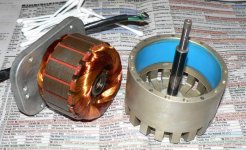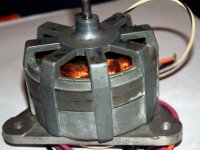I got one that run with 720RPM with 50V AC but the torque is a bit low to be used as a turntable motor.
Mikewong said:... but the torque is a bit low to be used as a turntable motor.
So long as it can keep the platter going round you don't need really much torque. Nottingham Analogue use such weedy motors that you have to start the platter moving by hand - the motor can't start it. That motor looks good to me.
😀 agreed, l had a no-name tt one time that once you put a dustbug on the lp had to be hand assisted to come up to speed, but once there kept going all day without missing a beat
cheers T.C.

cheers T.C.
honinbou,use the motor!
if its as good as it appears, use it! nothing wrong with low voltage.
As EC8010 points out, not much voltage is required to keep a motor spinning (and platter) once it is up to speed.
In fact to get a correct speed, you may have to alter the voltage (if DC type) or change the frequency if AC type and the voltage.
Air pax motors used in Linn LP12 turntables apparently run great when fed 72VAC or so...
stew
Edit: Spoonerisms edited out by moderator!
if its as good as it appears, use it! nothing wrong with low voltage.
As EC8010 points out, not much voltage is required to keep a motor spinning (and platter) once it is up to speed.
In fact to get a correct speed, you may have to alter the voltage (if DC type) or change the frequency if AC type and the voltage.
Air pax motors used in Linn LP12 turntables apparently run great when fed 72VAC or so...
stew
Edit: Spoonerisms edited out by moderator!
Mikewong said:I got one that run with 720RPM with 50V AC but the torque is a bit low to be used as a turntable motor.
And here is the attached photo.
Attachments
Mikewong...
if I recall, as motor speed drops, torque increases in a linear fashion (almost). Feed that motor with a different frequency, and drop the voltage. Speed will be reduced and torque will increase, perhaps making it suitable for a turntable. Or do some math, calculate the required platter speed, then make an intermediate pulley (2 stepped) to be driven by the motor and to drive the platter.
stew
Happy New Year to all, where ever you are 🙂
if I recall, as motor speed drops, torque increases in a linear fashion (almost). Feed that motor with a different frequency, and drop the voltage. Speed will be reduced and torque will increase, perhaps making it suitable for a turntable. Or do some math, calculate the required platter speed, then make an intermediate pulley (2 stepped) to be driven by the motor and to drive the platter.
stew
Happy New Year to all, where ever you are 🙂
Great find!
For interest, here's a link to photos of my Dyna Empire 208/Papst set on Flickr.
http://www.flickr.com/photos/worldwidephotographic/sets/72157603524842069/
Is yours a 3-phase EC motor like the Papst??? I'm still looking for a digital-analogue controller for mine.
For interest, here's a link to photos of my Dyna Empire 208/Papst set on Flickr.
http://www.flickr.com/photos/worldwidephotographic/sets/72157603524842069/
Is yours a 3-phase EC motor like the Papst??? I'm still looking for a digital-analogue controller for mine.
- Status
- Not open for further replies.
- Home
- Source & Line
- Analogue Source
- Japanese Papst on steroids (a Sony motor)

